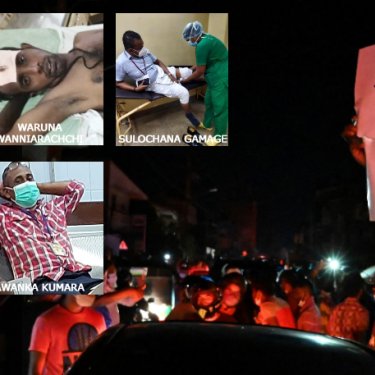At least nine journalists injured during Sri Lanka protests

Access to social media was cut off, many journalists have been harassed or attacked by police and at least nine have been injured in the course of the anti-government protests under way in Sri Lanka since 31 March. Reporters Without Borders (RSF) urges the government to let the media do its job, as this would help to end the crisis in the best manner possible.
The suppression of news and information was almost certainly the Sri Lankan government’s undeclared goal when it blocked social media throughout the island on 3 April, at a time when a curfew had already been in effect for 36 hours, backed by a state of emergency.
The large spontaneous demonstrations that erupted in the streets of Colombo, the capital, on the evening of 31 March are linked to an economic crisis, shortages and a decline in living conditions. Protests are continuing across the island.
Access to social media was finally restored after 15 hours of total blackout, but people have seen a sharp fall in Internet speed, several sources have told RSF. At the same time, many reporters trying to cover the protests have been subjected to often violent obstruction by police officers, above all members of the specially deployed Special Task Force (STF).
“Consultation is the best way out of this type of crisis and, to that end, all actors must be able to benefit from the reliable, verified and updated reporting that it is journalists’ job to provide,” said Daniel Bastard, the head of RSF’s Asia-Pacific desk. “This is why we are calling on President Gotabaya Rajapaksa to immediately end all attacks on social media on the island and to allow reporters to freely cover these historic protests. The attacks against them under the state of emergency are absolutely unacceptable.”
In a statement issued yesterday, the spokesperson for the UN High Commissioner for Human Rights voiced concern about the measures taken by the Sri Lankan authorities under the state of emergency because “they frustrate the exchange of views on matters of public interest.”
At least nine journalists injured
Sumedha Sanjeewa Gallage, a freelance journalist on assignment for local TV channel Derana TV, was violently attacked by police while covering a demonstration outside the entrance to the president’s residence in Colombo’s Mirihana district on the evening of 31 March by protesters chanting “Gota go Home.” Gota is the president’s nickname.
“I showed them my media identity card issued by the Government Information Department and screamed at them saying ‘I’m from the media’ but they assaulted me anyway,” Gallage told journalists afterwards.
He was taken, badly injured to Mirihana police station, where he was denied acess to immediate medical attention despite his repeated requests. According to the latest information obtained by RSF, he has lost partial vision in his right eye as a result of the attack and his condition is now described as concerning.
Three other journalists sent by Derana TV were injured during that evening’s protests. Lahiru Chamara, the first to arrive on the scene, sustained leg injuries from the blows he received. Nissanka Werapitiya was admitted to the national hospital in Colombo with serious injuries that required surgery the next day. The beating that Pradeep Wickramasinghe received from STF members left many visible marks on his body.
Two photographers with the English-language Daily Mirror newspaper were badly injured when hit by stones and other blunt objects. Nisal Baduge, who was hit on the head, said he only avoided more serious injury because he managed to find refuge in a nearby garden. His colleague, Waruna Wanniarachchi, was seen in several videos with his head bleeding as protesters rushed him to receive medical attention.
Awanka Kumara, a reporter for the Sinhalese TV channel Sirasa TV deliberately attacked by police officers, said in a tweet: “I never thought that journalists will be assaulted in such a manner, because they know us. We have been reporting these events for a long time.”
His colleague, Chatura Deshan, was also targeted by the police even though he clearly identified himself as a journalist. Their cameras were damaged during the attack.
Sulochana Gamage, a photo-journalist with the Lake House media group, was also injured while covering that evening’s protest outside the president’s residence.
Continuing press freedom violations
When MediaLK.com news website editor Tharindu Jayawardana returned to the scene of the previous night’s protest the next day, members of the president’s media division accosted him, ordered him to stop reporting and uttered verbal threats. Jayawardana said he had decided to file a complaint against them at the Mirihana police station.
Thisara Anuruddha Bandara, a young blogger, was taken from his home in Gampola, a town in the centre of the island, by several members of the security forces who arrived at dawn on 1 April. After several journalists sounded the alarm about Bandara’s disappearance, a senior police officer in the nearby coastal city Mutwal denied any knowledge of his arrest but he later admitted to the Sri Lankan Human Rights Commission that Bandara was indeed being held at his police station’s Crime Division. Bandara was released on bail the next day.
Sri Lanka is ranked 127th out of 180 countries in RSF's 2021 World Press Freedom Index.



